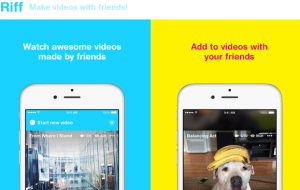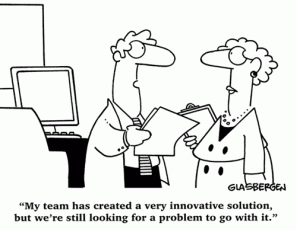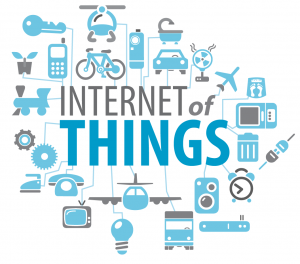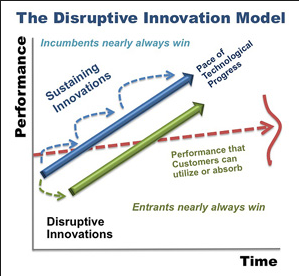Jacklin Altman
Facebook Introduces Riff
In an attempt to make videos “stickier” on social media, Facebook recently debuted its own video app called Riff. This Forbes article details the app and the logic behind it.
The way the app works is that users post 20 second videos, and then their friends can also post videos that can then be added on to the original video. When a user signs up for the app with their Facebook account, they can start making videos instantly, and their friends will receive notifications when their friends create videos. These videos will be connected by a common hashtag, thus creating a sort of video story that can be shared across various social media sites. The idea behind the app is that it makes the creative process more fun, by allowing users to collaborate with their friends.
A Facebook algorithm showed that at this time, videos take up approximately 30% of the average user’s newsfeed. This trend is what propelled the creation of Riff, which Facebook hopes will continue the trend.
What are your thoughts on the app? Do you think it can stand up to Vine and Snapchat stories, or do you think it’ll be soon forgotten? Would you use it?
Top 5 Risks for IT Projects
I found this article where the author lists what he believes to be the top 5 risks for IT projects. They are as follows:
1. Other projects getting prioritized over yours, thus taking funding away.
2. Project delays due to infrastructure/system upgrades.
3. Requirement changes/ updates to scope that mean additional work.
4. Project dates can be pushed due to an impact analysis that reveals additional issues/work to be done.
5. Coding can take longer than expected, as initial estimates may be wrong.
The author also mentions how critical it is to identify risks versus organizational issues. For instance, a lack of capabilities on the organizations part may lead to risks, though they are not risks themselves.
Do you think his list covers everything or are there more project risks that he hasn’t mentioned? Which risk would you say is the greatest?
How to Ace Your Performance Review
I know that I personally have always thought of performance reviews as uncomfortable sit-downs with the boss where I get talked at for a while, with little back and forth. I never thought that I had to play an active part in a review that was being conducted of me. However, the author of this Forbes article disagrees. She believes that one of the key aspects of a performance review should be you providing your own self-evaluation to your boss. Below are the steps that she says everyone should take to “ace their performance review.”
1. Don’t get overly emotional. It’s easy to take things personally, but try to keep things in perspective.
2. Prepare a self-evaluation throughout the year. Note all of your accomplishments and major contributions, as your boss is too busy to make note of every time you do something good.
3. Tell your boss where you need more support- this is also your chance to review your department.
4. Spell out your goals for the coming year. This will help you in next years review, as you can measure up against these goals.
5. Speak in plain English and avoid business jargon.
6. Handle criticism openly.
While most of the above are points that we have discussed, the self-evaluation concept is a new one. What are your thoughts on detailing all of your accomplishments throughout the year and listing them out to your boss? What’s the best way to go about t
The Internet Of Things & Energy Costs
For my disruptive innovation project, I looked at “The Internet of Things,” one of the top disruptive innovations recently, and an idea that I was not familiar with. This concept is that of things all around us, from watches to refrigerators, being embedded with sensors that allow these devices to communicate and share data. In doing some further research, I found this article about how The Internet of Things can help companies slash their energy costs- a concept that I had no considered.
While I think many people focus on The Internet of Things as a way to make people more connected and make our lives easier, I don’t think there’s enough focus on the good that IOT can do. The article talks about how companies can use smart grids, which will run on the IOT, which allow energy distribution to be evaluated in real-time, rather than based on historical data. This will allow companies to more effectively manage their energy usage, thus saving them money and helping the environment through reduced energy usage/waste.
What other potential do you see for IOT savings money and doing good? Do you think there are applications for a smart grid in a smaller sense, rather than just for businesses?
Why Disruptive Innovation is Not a Strategy
In light of our learning about disruptive innovation and reading about companies like Apple who have used it to their advantage, I found an article claiming that disruptive innovation is not a strategy and that companies should stop striving for it. The author, Soren Kaplan, explains how while many companies are striving to create disruptive innovation strategies, the inherent vagueness of the term makes it a lousy strategy. It’s not a linear method or process, and there is no way to capture how to do it.
The idea isn’t new- originally introduced in 1942 as “creative destruction” by economist Joseph Schumpeter, and it has since become an accepted paradigm, until Jill Lapore started to chip away at the idea. She believes that the concept of disruptive innovation “has been used as an argument for blowing up the broken healthcare and education systems, which minimizes the fact that these long standing institutions are complex social services delivered by human beings, not just stale technologies ready to be displaced by the next big thing.”
The author also goes on to explain how even one of the greatest innovators of all time, Steve Jobs, didn’t try to change the industry when he started Apple. He was quoted saying “When we created the iTunes Music Store, we did that because we thought it would be great to be able to buy music electronically, not because we had plans to redefine the music industry.” Kaplan goes in to cite the founders of Google as well, claiming that they too started with a basic vision, not a grand idea of disruptive innovation and changing the world.
Do you think that disruptive innovation is a sound business strategy? Is it something to strive for or is it just something that happens?
How to Report Progress
With our own progress reports coming due each week, I thought I would share this article that has some pointers for how to effectively communicate the status of a project. The author, Rob Redmond, states that to write an excellent status report you need to understand the three components of status, how to write brief details, and what key data is needed by management.
He describes the three components of status as:
- Overall: The overall project health
- Milestones: Major accomplishments with accompanying dates
- Issues: Obstacles to successful project completion
He then goes on to explain the concept of “brief details,” in which he suggests that when reporting a status you:
- Use bullet points instead of prose
- Avoid unnecessary titles
- Shorten sentences as much as possible
- Avoid adverbs
Lastly, key project data that should be communicated includes:
- Project Name
- Overall health (red, yellow, green can be used here)
- Current completion (in %)
- Expected project completion
- If you are ahead/behind schedule, if so, how much
- Issues you face
Do you agree with the author’s three-point structure for status reports? What do you think goes into writing a good status report? How have your status reports evolved after taking MIS 3535?
Innovation vs. Creativity
In class we talked about being innovative versus being creative. An article I read cites Shawn Hunter, author of “Out Think: How Innovative Leaders Drive Exceptional Outcomes,” who discerns the two as follows:
“Creativity is the capability or act of conceiving something original or unusual while innovation is the implementation or creation of something new that has realized value for others.”
The article goes on to discuss how creativity does not necessarily mean innovation, though it can lead to it. In a brainstorming session where ideas are flying around, that’s creativity. It isn’t until some value-driving idea is actually implemented that innovation sets in.
Shawn Hunter also chastises businesses for trying to create creativity on demand, by forcing employees into brainstorming sessions instead of focusing on building innovative processes and products. He claims that innovation doesn’t have to be the next big thing, it can simply be a tweak to a current process that makes the business operate better. He also states that it’s crucial that a business and its entire culture do everything possible to foster innovation in the workplace. The article cites the creation of the Starbucks Frappuccino as an example of innovation. Originally, the idea was rejected by company leaders. It wasn’t until the product was quietly made and sold to customers that it became a hit and was officially introduced into the product line.
Do you think that innovation and creativity necessarily need to go hand in hand? Can one exist without the other? Can one be successful without the other? In your experiences in the workplace, does management tend to focus more on innovation or creativity?








